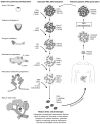Converting human pluripotent stem cells into beta-cells: recent advances and future challenges
- PMID: 19855279
- PMCID: PMC2832838
- DOI: 10.1097/MOT.0b013e3283337e1c
Converting human pluripotent stem cells into beta-cells: recent advances and future challenges
Abstract
Purpose of review: The transplantation of insulin-producing beta-cells derived from human embryonic stem cells and induced pluripotent stem cells (collectively termed pluripotent stem cells or PSCs) holds great promise for therapy of diabetes mellitus. The purpose of this review is to summarize recent advances in this area, emphasizing the importance of studies of endocrine pancreas development in efforts to direct PSC differentiation into endocrine cells, as well as to outline the major challenges remaining before transplantation of PSC-derived beta-cells can become a reality.
Recent findings: Although several protocols to generate glucose-responsive pancreatic beta-cells in vitro have been described, the most successful approaches are those that most closely mimic embryonic development of the endocrine pancreas. Until recently, cells generated by these methods have exhibited immature pancreatic endocrine phenotypes. However, protocols that generate more functional beta-like cells have now been described. In addition, small molecules are being used to improve protocols to direct differentiation of PSCs into endoderm and pancreatic lineages.
Summary: Advances over the last decade suggest that generating functional beta-cells from human PSCs is achievable. However, there are aspects of beta-cell development that are not well understood and are hampering generation of PSC-derived beta-cells. In particular, the signaling pathways that instruct endocrine progenitor cells to differentiate into mature and functional beta-cells are poorly understood. Other significant obstacles remain, including the need for safe and cost-effective differentiation methods for large-scale generation of transplantation quality beta-cells, methods to prevent immune rejection of grafted tissues, and amelioration of the risks of tumorigenesis.
Figures

References
-
- Narayan KM, Boyle JP, Geiss LS, Saaddine JB, Thompson TJ. Impact of recent increase in incidence on future diabetes burden: U.S., 2005-2050. Diabetes care. 2006 Sep;29(9):2114–6. - PubMed
-
- The Diabetes Control and Complications Trial Research Group The effect of intensive treatment of diabetes on the development and progression of long-term complications in insulin-dependent diabetes mellitus. The New England journal of medicine. 1993 Sep 30;329(14):977–86. - PubMed
-
- Nanji SA, Shapiro AM. Advances in pancreatic islet transplantation in humans. Diabetes, obesity & metabolism. 2006 Jan;8(1):15–25. - PubMed
-
- Shapiro AM, Lakey JR, Ryan EA, Korbutt GS, Toth E, Warnock GL, et al. Islet transplantation in seven patients with type 1 diabetes mellitus using a glucocorticoid-free immunosuppressive regimen. The New England journal of medicine. 2000 Jul 27;343(4):230–8. - PubMed
Publication types
MeSH terms
Grants and funding
LinkOut - more resources
Full Text Sources
Other Literature Sources
Medical
Research Materials

